A man walks past graffiti painted on a closed shop in the Monastiraki
area in central Athens: photo by Christian Hartmann/Reuters via FT Photo Diary, 7 July 2015
#Greece Travel Bookings From #Germany Collapsed 39%, Amadeus Says (via Bloomberg Business): image via Zoe Schneeweiss @ZSchneeweiss, 8 July 2015
Ouch!
Polish Right Wing MEP @mikkenews just called for a military coup in #Greece: image via Julian Röpcke @Julian Roepcke, 8 July 2015
George Seferis: Postscript
But their eyes are all white, without lashes
and their arms thin as reeds.
Lord, not with these people. I've known
the voices of children at dawn
rushing down green slopes
happy as bees, happy as butterflies
with so many colours.
Lord, not with these people, their voices
don't even leave their mouths --
they stay glued to their yellow teeth.
Yours is the sea and the wind
with a star hung in the firmament.
Lord, they don't know that we are
what we are able to be
healing our wounds with herbs
found on the green slopes,
these slopes nearby, not any others;
that we breathe as we are able to breathe
with a little prayer each dawn
that reaches the shore by crossing
the chasms of memory --
Lord, not with these people. Let your will be done in another way.
But their eyes are all white, without lashes
and their arms thin as reeds.
Lord, not with these people. I've known
the voices of children at dawn
rushing down green slopes
happy as bees, happy as butterflies
with so many colours.
Lord, not with these people, their voices
don't even leave their mouths --
they stay glued to their yellow teeth.
Yours is the sea and the wind
with a star hung in the firmament.
Lord, they don't know that we are
what we are able to be
healing our wounds with herbs
found on the green slopes,
these slopes nearby, not any others;
that we breathe as we are able to breathe
with a little prayer each dawn
that reaches the shore by crossing
the chasms of memory --
Lord, not with these people. Let your will be done in another way.
..............................
George Seferis (1900-1971): Postscript, from Logbook II (Alexandria, 1944), in Collected Poems, translated from the Greek by Edmund Keeley and Philip Sherrard, 1991
George Seferis (1900-1971): Postscript, from Logbook II (Alexandria, 1944), in Collected Poems, translated from the Greek by Edmund Keeley and Philip Sherrard, 1991
The day the Germans came to Kondomari
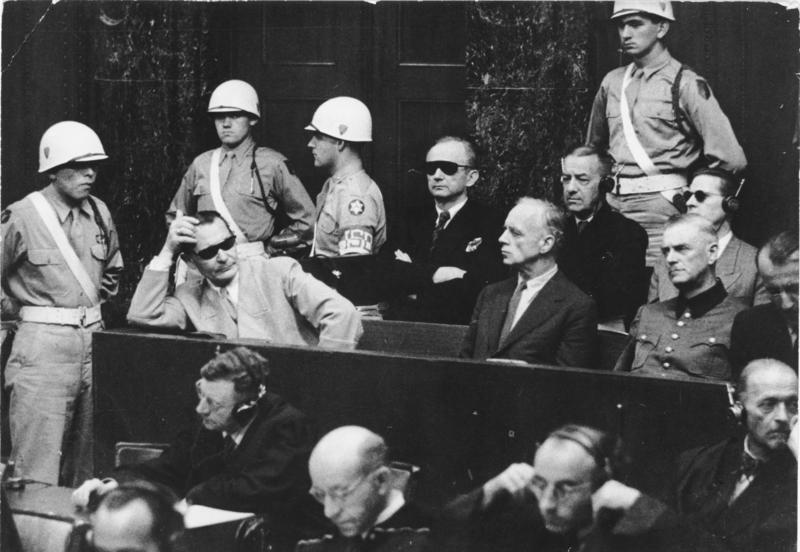
Hermann Göring (in dark glasses, leaning on the dock), at the Nuremberg trials, 1945: photographer unknown (Deutsches Bundesarchiv)
Source: Information supplied by Franz Peter WEIXLER
Krailling, near Munich, 11 November 1945
TRANSLATION BY Herma Plummer
Krailling, near Munich, 11 November 1945
TRANSLATION BY Herma Plummer
Goering Case
In
connection with the Nurnberg trials against Goering et al. I would like
to make the following statement with the express authorization that it
may be used in the trial.

Kondomari, Crete: photo by Franz Peter Weixler, 2 June 1941 (Deutsches Bundesarchiv; image by ww2gallery, 4 January 2015)
I was a prisoner of the Gestapo from January 16, 1944 to April 1945.
Kondomari, Crete: photo by Franz Peter Weixler, 2 June 1941 (Deutsches Bundesarchiv; image by ww2gallery, 4 January 2015)

Kondomari, Crete: photo by Franz Peter Weixler, 2 June 1941 (Deutsches Bundesarchiv; image by ww2gallery, 4 January 2015)
I
had been indicted for treason before the People's Court, and the only
reason I was not executed was the fact that my files were destroyed
once in Berlin, and once at the Gestapo office in Nurnberg.

Kondomari, Crete: photo by Franz Peter Weixler, 2 June 1941 (Deutsches Bundesarchiv; image by ww2gallery, 4 January 2015)

Kondomari, Crete: photo by Franz Peter Weixler, 2 June 1941 (Deutsches Bundesarchiv; image by ww2gallery, 4 January 2015)
One
of the reasons for my indictment was the fact that I had told friends
the truth about the parachute enterprise in Crete in May 1941, and also
the fact that I had taken pictures there.
I
am attaching an "order" of the German Army, which I appropriated and
kept, issued by the divisional staff of the Parachute Division,
commanded by General STUDENT.

Kondomari, Crete: photo by Franz Peter Weixler, 2 June 1941 (Deutsches Bundesarchiv; image by ww2gallery, 4 January 2015)

Kondomari, Crete: photo by Franz Peter Weixler, 2 June 1941 (Deutsches Bundesarchiv; image by ww2gallery, 4 January 2015)
I shall now describe the manner in which I was enabled to take the photos mentioned above.

Kondomari, Crete: photo by Franz Peter Weixler, 2 June 1941 (Deutsches Bundesarchiv; image by ww2gallery, 4 January 2015)
On June 1 or 2, 1941, I was in my billet in the capital of Crete, Chania, when a young officer told me that that afternoon I would see something very interesting.
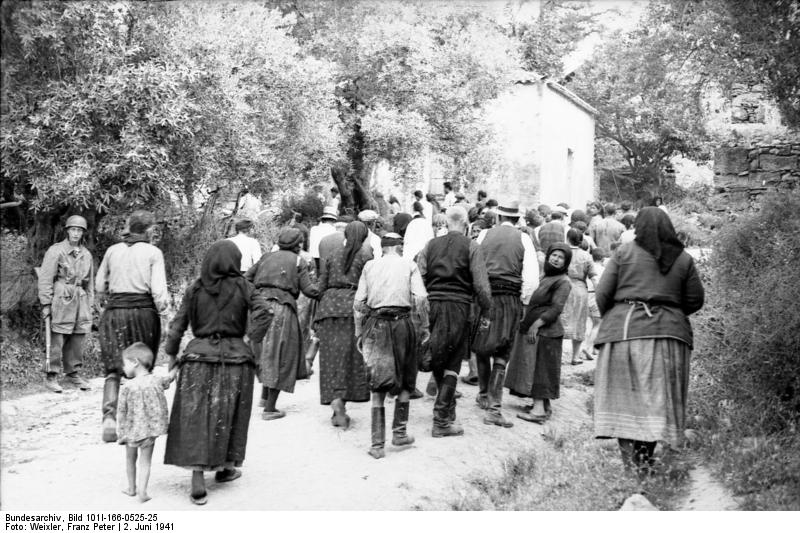
Kondomari, Crete: photo by Franz Peter Weixler, 2 June 1941 (Deutsches Bundesarchiv)
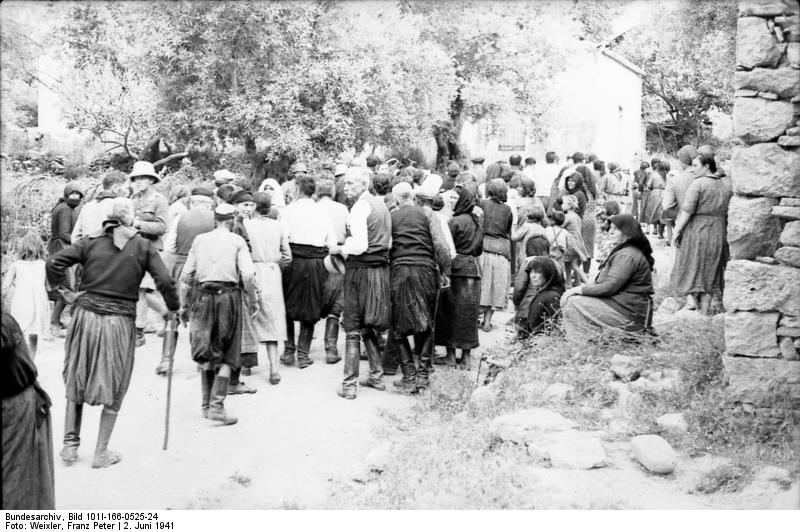
Kondomari, Crete: photo by Franz Peter Weixler, 2 June 1941 (Deutsches Bundesarchiv)
In
answer to my question he told me that a punitive expedition would be
sent against several villages since the corpses of parachutists,
massacred and plundered, had been found.

Kondomari, Crete: photo by Franz Peter Weixler, 2 June 1941 (Deutsches Bundesarchiv; image by ww2gallery, 4 January 2015)
The
supreme command of the Luftwaffe had been informed of this several days
before, and an order had been received from Goering according to which
'the sharpest measures', i.e. the shooting of the male population
between 18 and 50 years of age, was to take place.

Kondomari, Crete: photo by Franz Peter Weixler, 2 June 1941 (Deutsches Bundesarchiv; image by ww2gallery, 4 January 2015)
I
told the young officer and Captain GERICKE that I had never seen a
single massacred parachutist, but had seen dozens of dead comrades whose
faces had been partially destroyed because of the tropical heat.
I then went to see Major STENZLER who told me that a delegation of the German Foreign Office had left Berlin the day before in order to make an investigation concerning the alleged massacring of German soldiers.
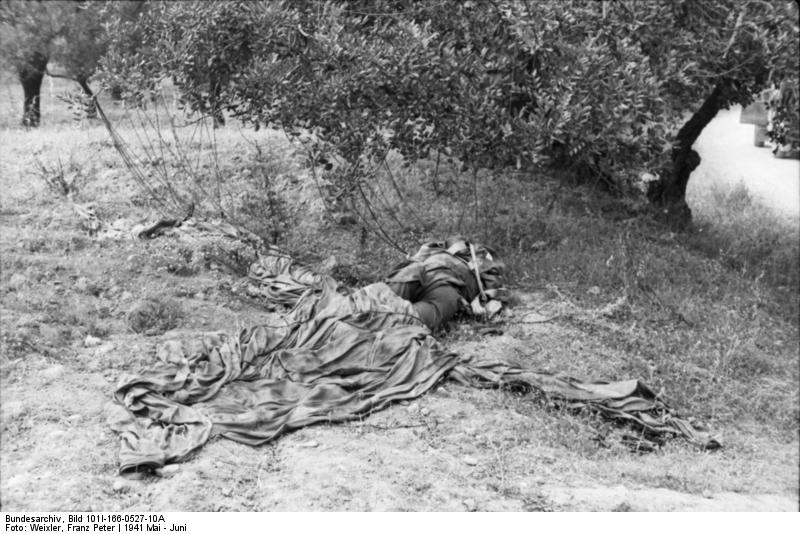
Fallen German parachutist, Crete: photo by Franz Peter Weixler, May/June 1941 (Deutsches Bundesarchiv; image by Historia Segunda Guerra Mundial, 4 April 2015)

Kondomari, Crete: photo by Franz Peter Weixler, 2 June 1941 (Deutsches Bundesarchiv; image by ww2gallery, 4 January 2015)

Kondomari, Crete: photo by Franz Peter Weixler, 2 June 1941 (Deutsches Bundesarchiv; image by ww2gallery, 4 January 2015)
I implored Major Stenzler not to send out the punitive expedition. He told me that this was none of my business.
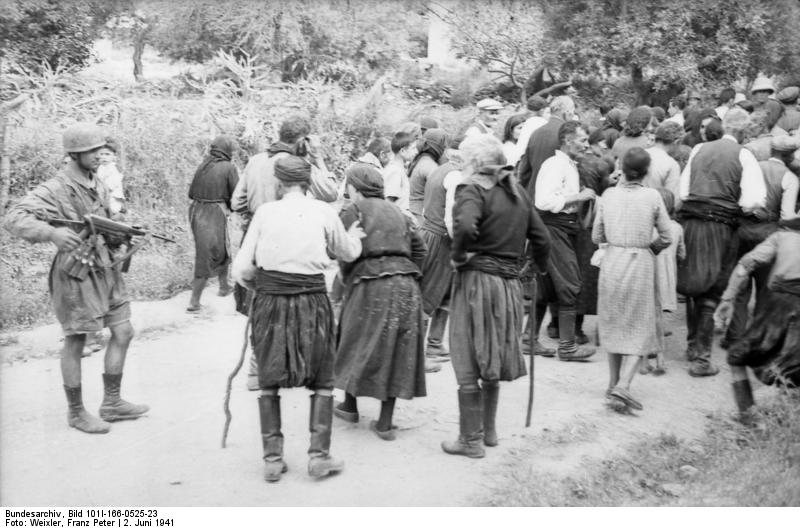
Kondomari, Crete: photo by Franz Peter Weixler, 2 June 1941 (Deutsches Bundesarchiv)
I went to see Lieutenant Trebes, who was just making a speech to a group of about 30 men, to the effect that "the action would have to be carried through as quickly as possible, as a reprisal for our comrades who had been murdered".

Oberleutnant Horst Trebes (right) at the ceremony to receive his decoration for 'valor' in Crete: photo by Franz Peter Weixler, 9 June 1941 (Deutsches Bundesarchiv)

Kondomari, Crete: photo by Franz Peter Weixler, 2 June 1941 (Deutsches Bundesarchiv; image by ww2gallery, 4 January 2015)
As a photographer assigned to my division I was permitted to accompany this Kommando [unit].

Kondomari, Crete: photo by Franz Peter Weixler, 2 June 1941 (Deutsches Bundesarchiv; image by ww2gallery, 4 January 2015)
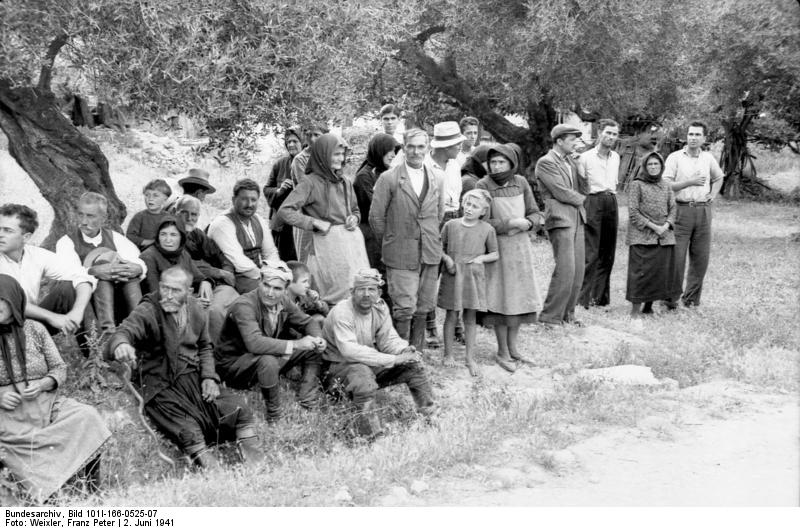
Kondomari, Crete: photo by Franz Peter Weixler, 2 June 1941 (Deutsches Bundesarchiv)
We continued our drive to the village of
Kondomari.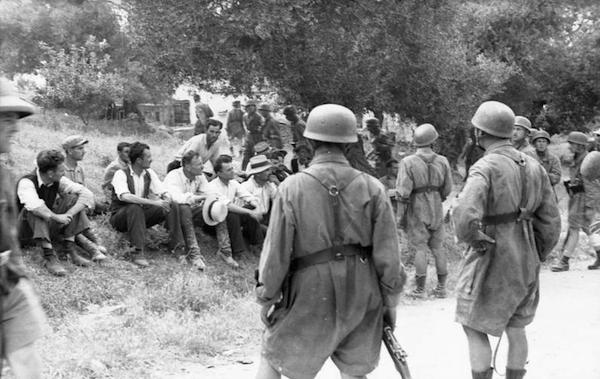
Kondomari, Crete: photo by Franz Peter Weixler, 2 June 1941 (Deutsches Bundesarchiv; image by The Pappas Post 28 May 2014)
The men got off, and ran into the few houses of the little community.

Kondomari, Crete: photo by Franz Peter Weixler, 2 June 1941 (Deutsches Bundesarchiv; image by ww2gallery, 4 January 2015)
They got all men, women, and children onto the little square.

Kondomari, Crete: photo by Franz Peter Weixler, 2 June 1941 (Deutsches Bundesarchiv; image by ww2gallery, 4 January 2015)

Kondomari, Crete: photo by Franz Peter Weixler, 2 June 1941 (Deutsches Bundesarchiv; image by ww2gallery, 4 January 2015)

Kondomari, Crete: photo by Franz Peter Weixler, 2 June 1941 (Deutsches Bundesarchiv; image by ww2gallery, 4 January 2015)

Kondomari, Crete: photo by Franz Peter Weixler, 2 June 1941 (Deutsches Bundesarchiv; image by ww2gallery, 4 January 2015)

Kondomari, Crete: photo by Franz Peter Weixler, 2 June 1941 (Deutsches Bundesarchiv; image by ww2gallery, 4 January 2015)

Kondomari, Crete: photo by Franz Peter Weixler, 2 June 1941 (Deutsches Bundesarchiv; image by ww2gallery, 4 January 2015)
Trebes had the men form a half circle, gave the order to fire, and after about fifteen seconds, everything was over.

Kondomari, Crete: photo by Franz Peter Weixler, 2 June 1941 (Deutsches Bundesarchiv; image by ww2gallery, 4 January 2015)

Kondomari, Crete: photo by Franz Peter Weixler, 2 June 1941 (Deutsches Bundesarchiv; image by ww2gallery, 4 January 2015)
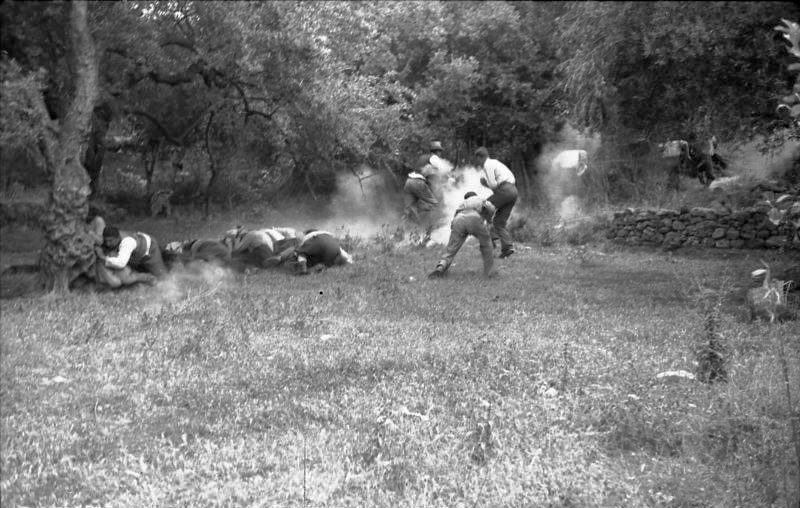
Kondomari, Crete: photo by Franz Peter Weixler, 2 June 1941 (Deutsches Bundesarchiv; image by Historia Segunda Guerra Mundial, 30 November 2013)
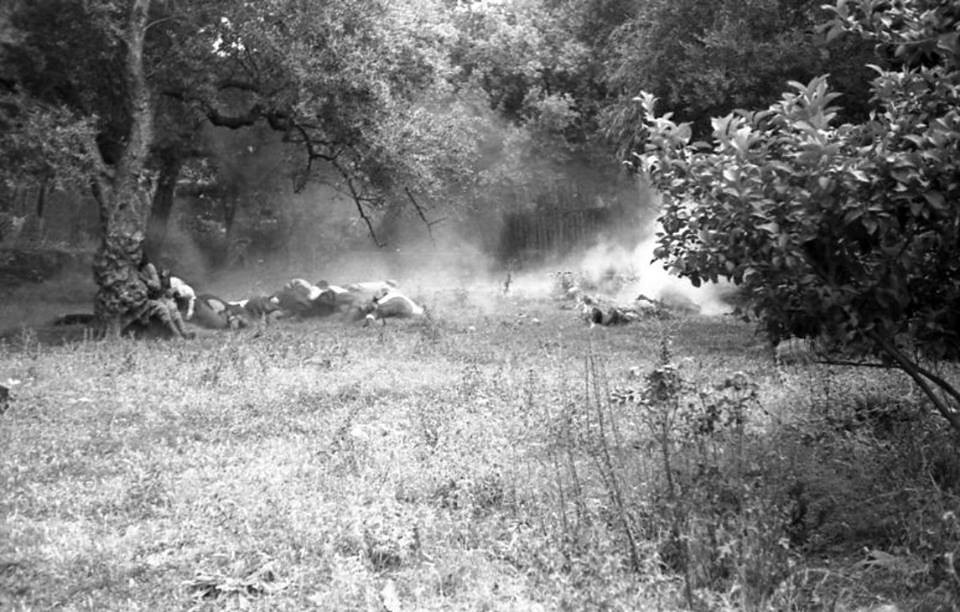
Kondomari, Crete: photo by Franz Peter Weixler, 2 June 1941 (Deutsches Bundesarchiv; image by Steve Hill, 18 May 2014)
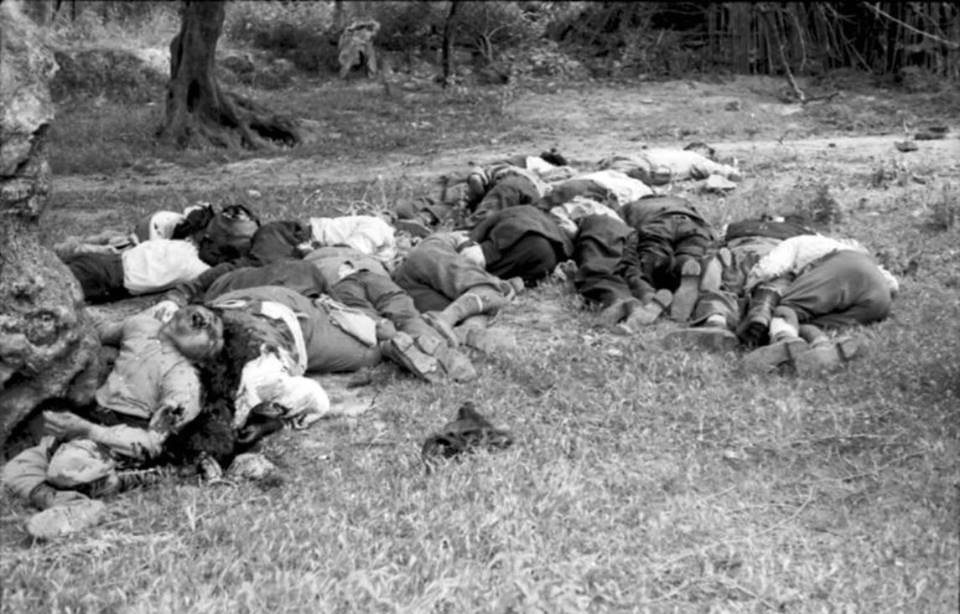
Kondomari, Crete: photo by Franz Peter Weixler, 2 June 1941 (Deutsches Bundesarchiv; image by Steve Hill, 18 May 2014)

Defendants in the dock, Nuremberg trials, 1945-1946: front row, left to right, Hermann Göring, Rudolf Hess, Joachim von Ribbentrop, Wilhelm Keitel; in second row, left to right, Karl Dönitz, Erich Raeder, Baldur von Schirach, Fritz Sauckel: photo by Office of the U.S. Chief of Counsel for the Prosecution of Axis Criminality/Still Picture Records LICON, Special Media Archives Services Division (NWCS-S) (National Archives and Records Administration)
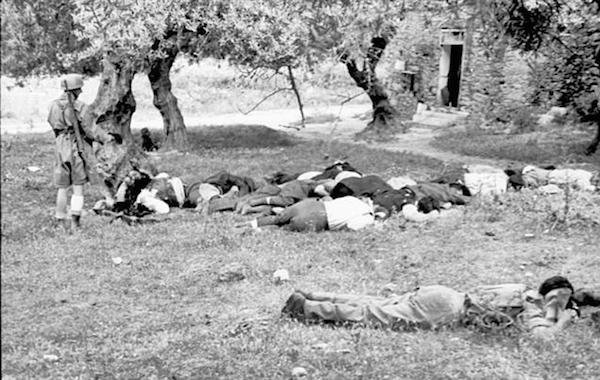
Kondomari, Crete: photo by Franz Peter Weixler, 2 June 1941 (Deutsches Bundesarchiv; image by The Pappas Post 28 May 2014)
It
was possible for me to get the negatives of my photos to a friend in
Athens, who saved copies.
Hermann Göring during cross-examination, Nuremberg trials, March 1946: photographer unknown (USHMM Photo Archives, courtesy of National Archives and Records Administration)
Franz Peter WEIXLER
Rebecca West: Göring at Nuremberg

German Reichsmarschall, Commander of the Luftwaffe Hermann Göring (1893-1946) during cross examination at his trial for war crimes in Room 600 at the Palace of Justice during the International Military Tribunal (IMT), Nuremberg, Germany, March 1946: photo by Raymond D'Addario, 3264th Signal Photo Service Company, US Army (National Archives, courtesy of USHMM Photo Archives)
And
though one had read surprising news of Göring for years, he still
surprised. He was so very soft. Sometimes he wore a German Air Force
uniform, and sometimes a light beach suit in the worst of playful
taste, and both hung loosely on him, giving him an air of pregnancy.
He had thick brown young hair, the coarse bright skin of an actor who
has used grease paint for decades, and the preternaturally deep
wrinkles of the drug addict. It added up to something like the head of
a ventriloquist’s dummy. He looked infinitely corrupt, and acted
naively. When the other defendants’ lawyers came to the door to
receive instructions, he often intervened and insisted on instructing
them himself, in spite of the evident fury of the defendants, which,
indeed, must have been poignant, since most of them might well have felt
that, had it not been for him, they never would have had to employ
these lawyers at all. One of these lawyers was a tiny little man of
very Jewish appearance, and when he stood in front of the dock, his head
hardly reaching to the top of it, and flapped his gown in annoyance
because Göring’s smiling wooden mask was bearing down between him and
his client, it was as if a ventriloquist had staged a quarrel between
two dummies.
View of the defendants in the dock at the International Military Tribunal trial of war criminals at Nuremberg [Göring, with US Army blanket draped over his lap, at far left in front row]: photographer unknown, November 1945 (National Archives, courtesy of USHMM Photo Archives)
Something
had happened to the architecture of the court which might happen in a
dream. It had always appeared that the panelled wall behind the dock
was solid. But one of the panels was really a door. It opened, and the
defendants came out one by one to stand between two guards and hear
what they had earned. Göring, in his loose suit, which through the
months had grown looser and looser, came through that door and looked
surprised, like a man in pajamas who opens a door our of his hotel room
in the belief that it leads to his bathroom and finds that he has
walked out into a public room. Earphones were handed him by the guard
and he put them on, but at once made a gesture to show that they were
not carrying the sound. They had had to put on a longer flex to reach
from the ground to the ear of a standing man, and the adjustment had
been faulty. His guards knelt down and worked on them. On the faces of
all the judges was written the thought, "Yes, this is a nightmare. This
failure of the earphones proves it," and it was written on his face
too. But he bent down and spoke to them and helped with the repair.
This man of fifty-three could see the fine wires without spectacles.
When the earphones were repaired he put them on with a steady hand and
learned that this was not a nightmare, he was not dreaming. He took
them off with something like a kingly gesture and went out, renouncing
the multitudinous words and gestures that must have occurred to him at
this moment. He was an inventive man and could not have had to look far
for a comment which, poetic, patriotic, sardonic, or obscene, would
certainly have held the ear of the court and sounded in history; and he
was a man without taste. Yet at this moment he had taste enough to
know that the idea of his death was more impressive than any of his
ideas.
Rebecca West: from Greenhouse with Cyclamens (I), 1946, in A Train of Powder, 1955
Defendants
in the dock at the Nuremberg trials, 1945; center row, from left,
Hermann Göring, Rudolf Hess, Joachim von Ribbentrop, Wilhem Keitel,
Ernst Kaltenbrunner: photographer unknown (Deutsches Bundesarchiv)

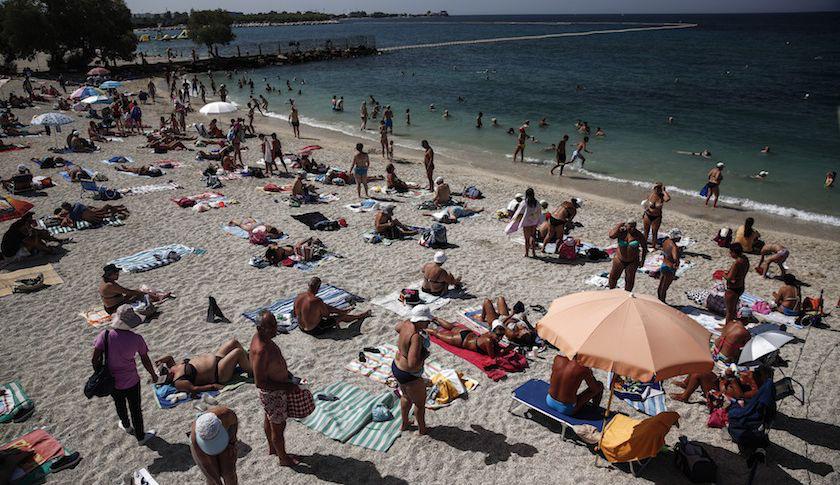



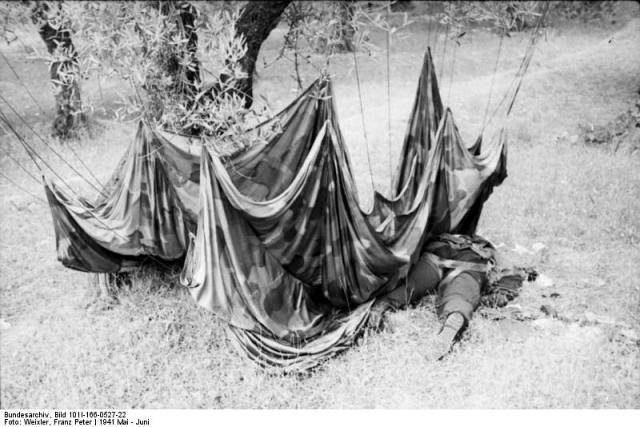


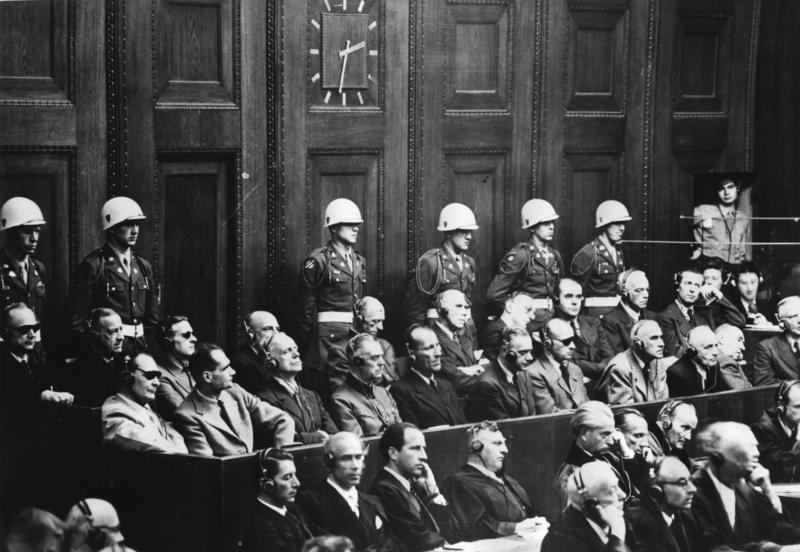



11 comments:
Tom, thought you might like this:
http://thewire.in/2015/07/08/thomas-piketty-germany-has-never-repaid-its-debts-it-has-no-right-to-lecture-greece/
Salams,
b.
ZEIT: So you’re telling us that the German Wirtschaftswunder [“economic miracle”] was based on the same kind of debt relief that we deny Greece today?
-- What's sauce for the goose, eh?
from Greece: Memory and Debt: Conn Hallinan, 7 April 2015:
"Memory is selective, and therein lies an explanation for some of the deep animosity between Berlin and Athens in the current debt crisis that has shaken the European Union (EU) to its foundations.
"For German Finance Minister Wolfgang Schauble, 'memory' goes back to 2007 when Greece was caught up in the worldwide financial conflagration touched off by American and European speculators. Berlin was a major donor in the 240 billion Euro 'bailout' -- 89 percent of which went to pay off the gambling debts of German, French, Dutch and British banks. Schauble wants that debt repaid.
"Millions of Greeks are concerned about unpaid debts as well, although their memories stretch back a little further...
*
"... massacres... most people in that country can recite them like the beads on a rosary: Kondomari (60 killed); Kardanos (180 killed); Alikianos (118 killed); Viannos (over 500 killed); Amari (164 killed); Kalavryta (over 700 killed); Distomo (214 killed)..
"The Greeks 'remember' a few .. things about those massacres. Gen. Kurt Student, the butcher of Kondomari, Kardanos, and Alikianos, was sentenced to five years after the war, but got out early on medical grounds...
*
"It is not hard to see why many Greeks see a certain relationship between what the Germans did to Greece during the occupation and what is being done to it today. There are no massacres -- although suicide rates are through the ceiling -- and no mass starvation, but 44 percent of the Greek people are now below the poverty line, the economy is shattered, and Greeks feel they no longer control their country. Up until the last election, they didn't. The “Troika” -- the European Central Bank, the European Commission, and the International Monetary Fund -- dictated the price of the loan: layoffs, wage and pension reductions, and huge cutbacks in health care. True, their occupiers did not wear the double thunderbolts of the SS or the field green of the Wehrmacht, but armies in pinstripes and silk ties can inflict a lot of damage.
"Germany dismisses the Greek demand for reparations -- estimated at anywhere from some 160 billion Euros to over 677 billion Euros -- as a long-dead issue that was decided back in 1960 when the Greek government signed a Bilateral Agreement with Berlin and accepted 115 million Deutschmarks in compensation.
"'It is our firm belief that questions of reparations and compensation have been legally and politically resolved,' said Steffen Seibert , a spokesperson for German Chancellor Angela Merkel. 'We should concentrate on current issues and, hopefully what will be a good future.'
"But that is a selective reading of history. There was never any 'resolution' of Nazi Germany's post-war debts because the country was divided between East and West. The 1953 Treaty of London cut Germany's obligations in half and stretched out debt payments, but the treaty did not address reparations because they were supposed to be resolved in the final peace treaty. However, with Germany divided, there was no such agreement.
"When Germany was unified in 1990, the Greeks raised the issue of reparations, but the Germans dismissed the issue as resolved by the combination of the London Treaty and the 1960 payoff. But not according to historian Hagen Fleischer, who has studied the reparations issue and the original loan documents. Fleischer says that Germany first argued that as long as the country was divided, Berlin could not consider repaying any debts. 'Then after German reunification Helmut Kohl [then Chancellor] and Hans-Dietrich Genscher [then Foreign Minister] said that it was now much too late. The matter was ancient history.'
[continues:]
"According to the Syriza government, the 115 million marks Germany paid in 1960 were only in compensation for Greek victims of Nazism, not the physical damage to the country, the destruction of the economy, or the forced loans.
"'Germany has never properly paid reparations for the damage done to Greece,' argues Greek Prime Minister Alexis Tspiras. 'After the reunification of Germany in 1990 the legal and political conditions were created for this issue to be solved. But since then, German governments chose silence, legal tricks and delay.'
"Many Greeks refuse to accept what they consider a paltry sum for the vast crimes of the occupation...
"... Germany has assets in Greece, including property and the Goethe Institute, a leading cultural center in Athens. Justice Minister Nikos Paraskevopoulos says he is ready to begin seizing German assets in Greece.
"Tsipras says Germany has a 'moral obligation' to pay reparations, a sentiment that some on the German left agree with. 'From a moral point of view, Germany ought to pay off these old compensations and the "war loan" that they got during the Occupation,' says Gabriele Zimmer of Die Linke, a party closely allied to Syriza in the European Parliament.
"Addressing the Greek Parliamentary Committee for Claiming the German Reparations on March 10, Tsipras asked 'Why do we tackle the past' instead of focusing on the future? 'But what country, what people can have a future if it does not honor its history and its struggles?'
"Dismissing the argument that reparations are ancient history -- 'The generation of the Occupation and the National Resistance is still living' -- Tsipras warned about the consequences of amnesia: 'The crimes and destruction caused by the troops of the Third Reich, across the Greek territory, but also across the entire Europe' are memories 'that must be preserved in the younger generations. We have a duty -- historical, political, ethical -- to preserve, remember forever what Nazism means, what fascism means.'
*
"Old memories certainly fuel Greek anger at Germany, but so do the current policies of enforced austerity that Berlin has played a pivotal role in inflicting on debt-ravaged Greece. 'Germany's Europe has finished,' says Greek Social Security Minister Dimitris Statoulis, the Europe 'where Germany forbids and all other countries execute orders.'"
http://weeklyhubris.com/two-poems-from-the-greek-underground/
Thanks, Vassilis --
The Germans picked up
The first men they came across
And when they had gathered
Enough to fill the ratio,
Shot them.
The ratio was thirty Greeks
For every German killed
By the Underground.
That would have been the calculus at Kondomari -- though it may be that the preponderance of dead parachutists were killed not by partisans but by hard landing in olive trees.
Should mention that in 1941, after the Nazi occupation of the Greek mainland, Seferis, serving as a press officer, accompanied the Greek government in exile -- first in Crete, then later, after the German invasion of Crete, in Egypt, where this poem was written (and later still, in South Africa).
And by the by, Franz Peter Weixler's quite amazing photos, presumed lost after the Nuremberg enquiry, turned up in the Deutsches Bundesarchiv files in the early 1980s...
I read the line "Lord, not with these people" and an image of the Hausfrau scratches itself on my retinas.
I hadn't read those poems of yours before, Vassilis. Remarkable. The bullet holes brought to my mind the wall behind Sacre Coeur - that great, vulgar, iced penitential cake - where you can still read the traces of the suppression of the Paris Commune.
Tom, French economist Thomas Piketty spoke about German hubris in regard to debt (non)payment.
http://thewire.in/2015/07/08/thomas-piketty-germany-has-never-repaid-its-debts-it-has-no-right-to-lecture-greece/
Absolutely amazing - and horrifying.
Many thanks to all, for caring, and for being there.
"Lord, not with these people" -- a line of unfortunately abundant, now perhaps near-infinite applicability, that's been ringing among the tangled noodleroni strands in the otherwise hollow chamber of the mind, here, among These People, for lo these many years.
Thomas Piketty is too right.
Vassilis may be righter still, in the way that experiencing the concrete effects of history makes one right -- if not happy.
Hilton's comment reminds us of the contribution to historical understanding of the events in Crete made by the man who, at considerable personal risk, and at the eventual cost of considerable personal sacrifice, refused to allow the horrors he had witnessed suffer the burial of forgetting.
What is known of the Kondomari massacre is known largely due to Franz Peter Weixler, whose documentation of the atrocity, in photos and in his later statement for the trial of Göring at Nuremberg, are salient historical materials --- though of a sort his Nazi superiors never intended to become public.
So perhaps a word or two about this man would be in order.
Weixler was Bavarian, born in Munich on 31 August 1899. He was forty-one at the time he was despatched to Crete as a Wehrmacht photographer.
Before the war he had attended secondary school and studied science at the Bank Graduate School in Berlin. He fought for Germany in the First World War. After the war he took up a career in banking. From 1922 to 1924 he headed the Berlin Stock Exchanges and Securities Division of the Credit Bank for Industry and Agriculture. He then worked until 1926 as Director of Reichsbund Bank AG. From 1926 to 1930 he co-owned Baukommandite Weixler & Co in Berlin.
From 1930 onwards he served as director of the Munich branch of the Prussia Pfandbriefanstalt; during this period, however, his political activities -- his involvement before 1933 in the Catholic Voluntary sector, his membership in the Christian Trade Union, the BVP and the Economic Advisory Council -- began to complicate his banking career. Weixler participated in the establishment of the Christian Social Union in Krailing and was a delegate to the Provincial Council and the National Assembly of the CSU. In 1933, in a decision likely motivated by professional exigency, he became a member of the Nazi Party and the SS; within months, however, in March 1934, he was expelled from both bodies.
He then became a member of various resistance groups. In 1934 he was arrested, and a special court proceeding was initiated against him; the court action was discontinued due to an amnesty. 1937 his political resistance against the Third Reich caused his dismissal from the Pfandbriefanstalt, and effectively made him unemployable in the banking sector.
Thereafter he worked as a free-lance writer and photographer until conscription again made a soldier out of him; but, it seems, by then, hardly a willing one. In May of 1941, in his capacity as Wehrmacht kriegsberichter (war correspondent) he was sent to accompany the Fallschirmjager (paratroopers) in the invasion of Crete. But there Weixler's military career would come to an end. The revulsion that overcame him on the terrible day at Kondomari was evident and duly noted by those around and above him in the German ranks. He was soon dismissed from the military, officially classified as 'unworthy to bear arms'. In 1943 he was arrested again; charged with sedition and treason, he was imprisoned from January 1944 to April 1945.
Franz Peter Weixler died on the 23rd of April, 1971 in Bad Reichenhall, Bavaria.
There's a 2004 photo of the memorial site for the victims of the Kondomari massacre, here.
A minor personal aside -- when I travelled the length and breadth of Crete, on foot and by the lovely humble and ultra-educational democratic form of travel then possible, known as "auto-stop", exactly twenty-years after the German invasion, I learned that, particularly in the western end of the isle, while the hospitality and generosity of common people toward strangers was quite remarkable, it was not a good idea to utter so much as a word concerning the Germans.
Post a Comment